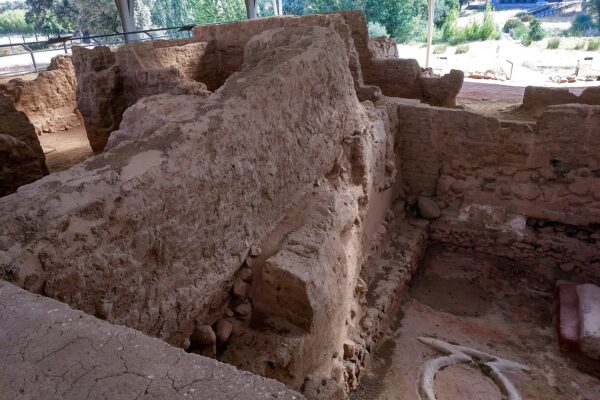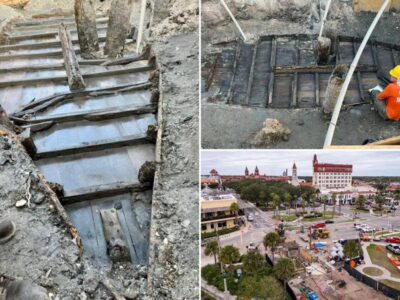
Researchers digging at a recently uncovered site in Spain have shocked the world of archeology. They have found the gods of an ancient culture that once thrived on the Iberian Peninsula but burned their entire civilization to the ground 2,500 years ago for some unknown reason.
Archeologists excavating a site in Casas Del Turuneulo discovered the first human sculptures of the Tartessos people, a culture that, according to Heritage Daily, “emerged during the Late Bronze Age in the Southwest Iberian Peninsula of Spain. The culture is characterized as having a mixture of local Paleo-Hispanic and Phoenician traits, while speaking a now extinct language called Tartessian.
The Tartessos people were skilled in metallurgy and metal working, creating ornate objects and decorative items. Characteristic Tartessian bronzes include pear-shaped jugs, shallow dish-shaped braziers with loop handles, incense-burners with floral motifs, fibulas and belt buckles.
They are believed to have worshiped the goddess Astarte or Potnia, and the masculine divinity Baal or Melkar. This was due to acculturation by their Phoenician trading partners.”
The Spanish National Research Council said in a statement that “the team of the Institute of Archaeology, a joint center of the Higher Council for Scientific Research (CSIC) and the Junta de Extremadura, led by Esther Rodríguez González and Sebastián Celestino Pérez, has confirmed today at a press conference that, of the set recovered to date, two of the figurative reliefs are almost complete and correspond to female figures adorned with outstanding earrings or arracadas that represent typical pieces of the Tartessian goldsmithing.
Until now, these gold pieces were only known through the findings made in enclaves such as the Cancho Roano site or within the set that makes up the treasure of Aliseda, a Tartessian funerary trousseau found in Cáceres. Given the technical quality and artistic detail with which they were made, it seems that we are facing the representation of two female divinities of the Tartessian pantheon. However, the researchers do not rule out that they are prominent figures in Tartessian society.
Along with the two female figures, other fragments of reliefs have been recovered. These belong to at least three other individuals, one of them identified as a warrior when part of the helmet is preserved.
This extraordinary finding represents a profound paradigm shift in the interpretation of Tartessus, traditionally considered as an aniconic culture for representing divinity through animal or plant motifs, or through betyls (sacred stones). Finally, the finding only further emphasizes both the importance of the site and the transcendence of the Tartessian culture in the Guadiana valley during its last moments.”
Four cows , four pigs , a dog and up to 52 horses were offered to the gods more than 2,500 years ago in a rural farm in the southwest of Spain. There's been more revealed about this interesting site of the Tartessos civilization. pic.twitter.com/VFeA2E71wX
— Skionar (@Skionar) August 25, 2019
Tartessos was the first Iberian culture known to have traded across the Mediterranean, as far as present-day Israel, Greece, and Egypt, and its wealth was famous throughout the region. Some researchers, including archaeologist Richard Freund of Christopher Newport University, have even suggested that the port city of Tartessos, the heart of the civilization, may have been the inspiration for the mythical Atlantis. The idea stems from Aristotle’s linking of a river in southern Spain with both Atlantis and Tartessos. Herodotus wrote that Tartessos was a culture beyond the Pillars of Hercules, a term from antiquity commonly understood to mean the rock of Gibraltar and the Moroccan mountains that face it across the strait. Another Greek historian, Ephorus, described Tartessos as prosperous, “with much tin carried by river, as well as gold and copper.” The wealth, advanced technology, and reach of Tartessos are also mentioned in the writings of other sources from the era. “Their sophistication was remarkable,” says Freund.
Why Tartessos vanished remains a mystery. Celestino thinks that one or more major earthquakes, and subsequent tsunamis, may have destroyed most of its coastal settlements and demoralized survivors,” wrote Atlas Obscura.
The new findings might offer clue as to why the Tartessos people burned everything they had and left.
Vice noted that “the discovery of five reliefs of human faces at the ancient Tartessian site of Casas del Turuñuelo has revealed unexpected details about this Bronze Age society that mysteriously vanished around 2,500 years ago. Though these peoples produced an abundance of gorgeous artifacts, these reliefs are the first human representations excavated at the site, adding a surprising new layer to our understanding of this vibrant culture.
The human faces date back to the 5th century BCE, at the tail end of this centuries-long civilization that has enchanted both ancient and modern scholars. Two of the most well-preserved reliefs appear to depict women who might have been goddesses in the Tartessian pantheon, according to a team led by Esther Rodríguez González and Sebastián Celestino Pérez of CSIC’s Institute of Archaeology.
A third figure adorned with a helmet could be a Tartessian warrior, the researchers said. The remaining pair of reliefs are more poorly preserved, but they may also be deities that were watching over the warrior as part of a larger sculpted scene.
The human reliefs were found in an ancient adobe temple that is filled with the bones of animals that were killed, eaten, and deposited in a pit during a mass sacrifice. For some unknown reason, the site was then intentionally sealed and burned to the ground as part of a ritual that appears to have been common among the Tartessos, as the nearby Tartessian sites of Cancho Roano and La Mata were also torched in a similar manner.”
Over the past few years, Spanish researchers have launched the “Building Tarteso” project, which aims to understand more about the Tartesso culture.
The project’s website explains: “The main objective is to characterize the Tartessian material culture through the architectural analysis of the large adobe buildings excavated in recent decades. To date, the works related to Tartessian architecture have focused on the analysis of the floors of the buildings and the testing of some interpretations about their possible function, but they lack a study of the architectural model. Our goal is to introduce the concept of architecture as an integrated element in the territory, while we consider fundamental the analysis of the perception that the society of the time had of that architecture and how it could impact on the social mentality.”










[…] [Read More: Undiscovered Ancient ‘Gods’ Found In Spain] […]